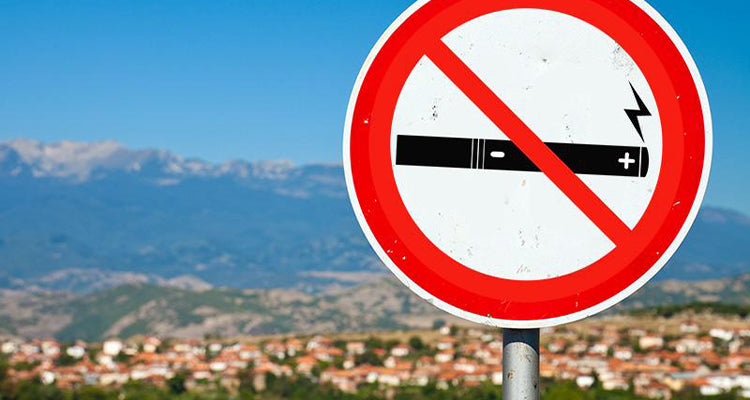By Dr. Konstantinos Farsalinos
A new document was released by an organization called Global Advisors on SmokeFree Policy (GASP), demonizing electronic cigarettes. The document, signed by Karen Bluemenfeld, who does not seem to be a physician or any other kind of specialist in tobacco harm and harm-reduction products, is a 21 page black propaganda against e-cigarettes, without any scientific documentation besides the attempt to misinform, mispresent and selectively present information suitable to support the predetermined position that e-cigarettes are bad for the health.
It starts by presenting legislation in various US states where e-cigarettes have been banned from public places. I wonder how legislation could be considered scientific proof or argument for the harm caused by e-cigarettes. It is rather proof that e-cigarettes opponents have succeeded in misinforming health boards and the public. Although they have extensively searched for and have found every case of law enforcement on e-cigarette bans, they have forgot (?) to report that FDA lost in US courts and health ministries have also lost court battles in Germany, the Netherlands and Estonia when they wanted to impose a ban on e-cigarettes. Interestingly, they still report a 2011 proposal for banning sales in Greece, failing to inform that e-cigarettes are sold legally all this time and even now (and will continue to be available).
On page 5, they use as argument a poll (!!) done by the University of Michigan, finding that the majority of people want regulation (but not a ban) on e-cigarette sales. Since when have polls become a reasonable scientific proof or argument for imposing bans or restricting availability of any product?
On page 5 again, they say that e-cigarettes are “smoked”, therefore they should be prohibited. They also quote statements on websites of businesses discussing about smoke created. The irony is that the statement says: “The EVO is an electronic, smokeless alternative that delivers true tobacco flavor through a vapor mist smoke, with your preferred level of nicotine.” I would change that (using the exact same words), making it like this: “The EVO is an electronic, smokeless alternative that delivers true tobacco flavor through avapor mist smoke, with your preferred level of nicotine.” Moreover, if I state that I am as genius as Einstein, will you make me head of MIT or NASA?
Did you expect that the famous FDA chemical study would not have been mentioned? You were wrong; on page 6 they extensively describe the results of FDA. Of course, there is no mention on the hundreds of chemical studies performed since then (more than 400 performed in Greece, in university laboratories), finding no or minimal levels of carcinogenic substances. In fact, Prof Siegel found that the level of carcinogens were similar to FDA-approved nicotine replacement therapy (but of course they don’t mention this). Once again, GASP failed to inform us that all these substances are present in the atmosphere, and it is the amount that matter, not just their presence.
World Health Organization is mentioned on page 7, claiming that “no proof that they (e-cigarettes-are safe or effective in nicotine substitution”. OK then, let’s wait for 20 years until they are proven safe in long-term use. But hold on, if they are not available for people to use, how will we even know how safe they are on the long run?
Then, they quote the university of Athens study on respiratory function. A funny thing is that on page 6 they say: “Persons with breathing disabilities may especially have their lung functioning compromised, due to exposure to e-cigarette byproducts like propylene glycol…”, failing to note that the University of Athens found absolutely no adverse effects of e-cigarettes when used by patients with respiratory disease.
Since I’ve heard so many times about the irritating effect of propylene glycol, a study by Robertson and colleagues in 1947 (yes, you saw it right, 1947) found absolutely no problem in experimental animals after they were exposed for several months in air fully saturated with propylene glycol vapor! Also, they forgot to mention my study presented last year during the annual congress of the European Society of Cardiology about the effects of e-cigarette use on myocardial function. Probably they didn’t like the results: “The investigators found significant defects in the diastolic phase of left ventricular function after smoking one cigarette, with four echocardiographic parameters indicating worsening function. In contrast, none of the echocardiographic parameters showed any significant worsening in subjects after using the electronic cigarette.” And, probably, they didn’t like my quote: “…considering the extreme hazards associated with cigarette smoking, currently available data suggest that electronic cigarettes are far less harmful and substituting tobacco with electronic cigarettes may be beneficial to health.”
Moreover, they fail to mention the only respiratory study which has compared vaping with smoking and has been published. In that study they found minimal effects of e-cigarette use on respiratory function, compared to significant effects after active and passive smoking. The European Respiratory Society mentions that smokers should follow the recommended smoking cessation treatments; however, they do not mention what should be done for the (more than) 80% of smokers who fail to reduce or quit smoking with these methods.
They continue by analyzing the study published in the journal “Indoor Air” about passive vaping. Shockingly, they report the detection of toxic chemicals, including acetic acid!!! The name may be impressive and looks like something dangerous; however, acetic acid is simply vinegar!!! The report also fails to mention a very important observation of this study: “However, continuous monitoring only showed a slight increase in the formaldehyde concentration in the 8-m3 emission test chamber before and during the consumption of the three liquids (see Table 4 and Figure 2). This might be caused by the person in the chamber itself, because people are known to exhale formaldehyde in low amounts (Riess et al., 2010) and the increase was already observed during the conditioning phase” (conditioning phase is the time BEFORE e-cigarette was used). And the authors continued: “Furthermore, the release of formaldehyde was also below the limit of detection in the small-scale experiments.”
Page 8 and 9 are dedicated to a report from Schroeder Institute for tobacco Research. They say that e-cigarettes are ineffective because of fluctuating nicotine content and unpredictable delivery. Now, I always hear that same argument, but none has realized that smoking cigarettes also is unpredictable. All smokers experience different delivery, according to their smoking habits (puff duration, interpuff interval, and depth of inhalation). Despite that, cigarettes are quite successful in keeping smokers within the habit. On the contrary, products with accurate nicotine levels and predictable delivery (nicotine replacement therapy) are effective in less than 7% of cases!!! I doubt there is (or will be) any method less successful than that. The issue of e-cigarettes being a “bridge product” for tobacco cigarettes is something difficult to understand. If someone wants to start smoking, why would he use a bridge-product? Cigarettes are available everywhere.
This is completely meaningless… In any case, based on this thinking, we could ban several common products available in the market, like tea, Twix, and Smarties – They can all be smoked and considered bridge-products to tobacco cigarettes.
The story about the dangers of e-cigarettes because someone in Florida lost his teeth was expected to show up. We have to understand that e-cigarettes are not made from some exotic materials coming from another planet. The lithium batteries used are similar to any lithium battery used in flash lights, mobile phones and several other devices. In fact, there are more cases of mobile phone explosions than e-cigarette explosions. Has anyone thought of banning mobile phones?
A very common argument is that e-cigarettes appeal to the young. I wonder how you can support that when no study has ever found a non-smoker youngster using e-cigarettes. I agree with them that e-liquid could be consumed by a child, leading to acute poisoning. The same things have happened with cleaning products, accidents have happened with electrical appliances, toys etc. Should we ban all of them?
Nicotine has been presented as the most lethal substance in the world. And they make some really novice claims, like that it is carcinogenic and causes cardiovascular disease. That triggers me to pose 3 questions:
- Why is nicotine not listed as a carcinogen by the World Health Organization?
- Why do major reviews by respected cardiovascular physicians state that nicotine has minimal effects in causing heart disease or thrombosis?
- If this organization knows something more that all scientists do, why don’t they ask to ban the sales of nicotine replacement products, which contain this dangerous substance? But, as they mention in page 12, nicotine is good only when it is approved by the FDA!!
In conclusion, the document by Global Advisors on SmokeFree Policy (GASP) is a report consisting of misinterpreting data, mispresenting science and selectively ignoring facts that do not fit into their opinion that e-cigarettes, the most promising product in reducing smoking-related harm, should be banned from the market and thus deprive smokers from a very effective tool in their battle to improve their health.






